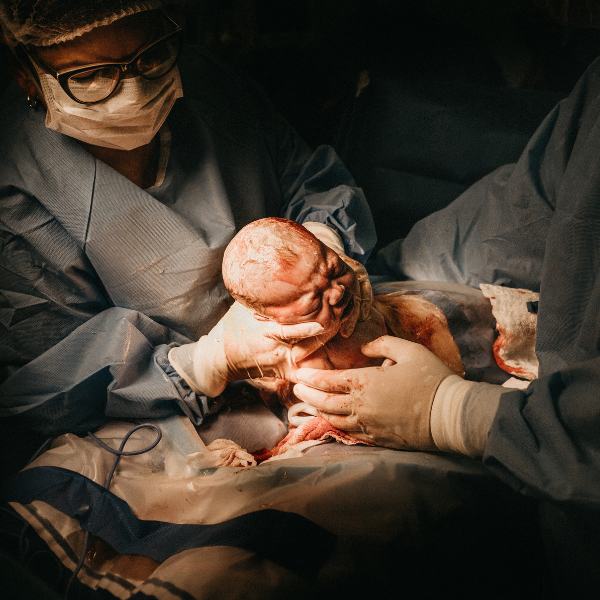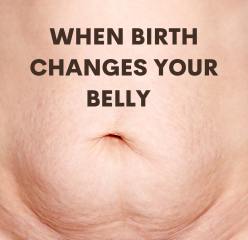If you’ve had both a Caeserean and a vaginal birth, you might have noticed a difference in your stomach after c-section vs natural birth.
You will have heard of the infamous c-section pooch. Is it a real thing? Does it ever go away? In this article, we’ll consider both of those questions.
Before we go any further, let us start by establishing this: yes, it is normal for your tummy to look very different and sometimes even downright strange after a c-section.
5 Reasons why your stomach different after c-section vs natural birth

After undergoing a cesarean section (C-section) delivery, it is common for women to experience changes in their stomach. Here are a few reasons why your stomach may be different after a C-section:
- Incision Scar: One of the most noticeable changes is the presence of a scar from the C-section incision. This scar may appear as a horizontal or vertical line on the lower abdomen. Over time, the scar may fade but can still be visible.
- Swelling and Inflammation: After a C-section, you may experience swelling and inflammation around the incision site and the surrounding tissues. This can cause your stomach to feel larger or appear more bloated.
- Abdominal Muscle Separation: During pregnancy, the abdominal muscles stretch to accommodate the growing baby. In some cases, the abdominal muscles may separate, a condition called diastasis recti. This can lead to a bulging or protruding appearance of the stomach after c section vs natural.
- Changes in Skin Elasticity: Pregnancy and C-section delivery can affect the elasticity of your skin. You may notice looser or sagging skin around the stomach area.
- Scar Tissue Formation: Scar tissue can form internally after a C-section, which may cause adhesions or tightness in the abdominal area. This can contribute to changes in the appearance and feel of your stomach after c section vs natural.
It’s important to remember that every woman’s body is different, and the extent of these changes can vary. If you have concerns about your post-C-section stomach, it’s best to consult with your healthcare provider for personalized advice and guidance.
Does the belly pooch go away after a c-section?
The belly pooch that develops after a cesarean section (C-section) can vary from person to person. The extent to which the belly pooch goes away depends on various factors, including individual body composition, genetics, exercise, and overall health.

After a C-section, it is common for the abdomen to feel swollen and for the incision area to be tender. This is due to the healing process and the stretching of the abdominal muscles during pregnancy.
In the immediate weeks following the procedure, the belly pooch may still be present, and the abdomen might appear swollen or protruded.
Over time, as the body heals and adjusts, the swelling usually decreases, and the belly pooch can diminish. However, it’s important to note that every person’s body is unique, and individual experiences may vary.
Some factors that can affect the recovery and the reduction of the belly pooch include:
- Time: It takes time for the body to heal and for the uterus to shrink back to its pre-pregnancy size. It can take several weeks or even months for the belly pooch to decrease.
- Exercise and physical activity: Engaging in regular exercise and physical activity, as advised by your healthcare provider, can help tone and strengthen the abdominal muscles, which can contribute to reducing the belly pooch. However, it’s important to follow a safe and gradual exercise routine, considering the post-C-section recovery period.
- Diet and nutrition: Maintaining a healthy and balanced diet can support overall weight loss and body composition. Eating nutrient-rich foods and avoiding excessive calorie intake can aid in reducing the belly pooch.
- Postpartum support garments: Wearing postpartum support garments, such as abdominal binders or compression garments, can provide support to the abdominal muscles, help with healing, and potentially assist in reducing the appearance of the belly pooch.
- Individual factors: Each person’s body is different, and genetics can play a role in how the abdomen recovers after a C-section. Some individuals may find it easier to regain their pre-pregnancy abdominal shape, while others may experience more difficulty.
It’s essential to remember that patience and self-compassion are crucial during the postpartum period.
If you have concerns about your post-C-section recovery or the appearance of your abdomen, it’s recommended to consult with your healthcare provider, who can provide personalized advice based on your specific circumstances.
READ: How to get rid of an apron belly without surgery

Is it harder to lose weight after a c-section?
Losing weight after a C-section can be challenging for some individuals, but it’s important to note that the difficulty in losing weight can vary from person to person. Here are a few reasons why weight loss may be perceived as more challenging after a C-section:
- Recovery period: After a C-section, the body needs time to heal, and it’s generally recommended to wait until the incision has healed and your healthcare provider has given you the green light to resume physical activity. This recovery period may limit the ability to engage in vigorous exercise or certain activities that could aid in weight loss.
- Hormonal changes: Pregnancy and childbirth result in significant hormonal changes in the body. These hormonal fluctuations can affect metabolism and contribute to weight retention or slow down the weight loss process.
- Physical discomfort: The abdominal incision and the healing process can cause discomfort and pain, making it challenging to engage in physical activities that could aid in weight loss. Additionally, the abdominal muscles may be weakened, and core exercises could be more difficult to perform initially.
- Sleep deprivation: Caring for a newborn often involves disrupted sleep patterns, which can impact overall energy levels and make it harder to engage in regular exercise or maintain a balanced diet. Sleep deprivation has also been linked to increased cravings for unhealthy food and a higher likelihood of weight gain.
- Stress and emotional factors: The postpartum period can be emotionally challenging, and stress levels may be elevated. Stress can influence weight loss by triggering emotional eating or affecting hormonal balance.

Despite these challenges, it is still possible to lose weight after a C-section. Here are some strategies that may be helpful.
4 Ways to lose weight after a C-Section

- Gradual approach: Start with gentle exercises and gradually increase intensity as your body heals and you gain more energy.
- Focus on nutrition: Pay attention to your diet and aim for a well-balanced, nutrient-rich meal plan. Including plenty of fruits, vegetables, lean proteins, and whole grains can support weight loss.
- Breastfeeding: If you are breastfeeding, it can help with weight loss as it burns extra calories. However, it’s important to prioritize your overall health and ensure you’re consuming enough nutrients to support both your body’s recovery and milk production.
- Seek support: Reach out to healthcare professionals, such as a registered dietitian or a postpartum fitness specialist, who can provide personalized guidance and support tailored to your needs.
Remember, weight loss is a gradual process, and it’s important to be patient and kind to yourself during the postpartum period. Every person’s journey is unique, and it’s essential to focus on overall well-being rather than solely on the number on the scale.
7 Ways to tighten your tummy after a c-section

Tightening the tummy after a C-section can take time and patience as the body heals. Here are some strategies that may help in tightening the abdominal muscles:
- Consult with your healthcare provider: Before starting any post-C-section exercise regimen, it’s crucial to consult with your healthcare provider. They can assess your individual situation, consider any specific factors related to your recovery, and provide personalized advice.
- Postpartum exercises: Engaging in gentle postpartum exercises can help strengthen and tone the abdominal muscles. Initially, focus on exercises that are safe and appropriate for the early postpartum period, such as pelvic floor exercises, deep abdominal breathing, and gentle stretching. As your body heals, gradually progress to exercises that target the core muscles, such as abdominal bracing, modified planks, or exercises recommended by a physical therapist or postpartum fitness specialist.
- Incorporate cardio exercises: Cardiovascular exercises, such as brisk walking or low-impact aerobic activities, can help burn calories and contribute to overall weight loss. However, start slowly and gradually increase the intensity as your body heals.
- Pelvic floor exercises: Strengthening the pelvic floor muscles is essential after a C-section. Pelvic floor exercises, also known as Kegel exercises, can be performed to improve core stability and support the abdominal muscles. Consult with a healthcare provider or a pelvic floor physical therapist for guidance on proper technique and exercises that are suitable for your specific needs.
- Consider wearing postpartum support garments: Postpartum support garments, such as abdominal binders or compression garments, can provide support to the abdominal muscles, help with healing, and potentially aid in tightening the tummy. Consult with your healthcare provider or a postpartum specialist to determine if using such garments would be beneficial for you.
- Maintain a healthy diet: Consuming a balanced and nutritious diet can support overall weight loss and contribute to a tighter tummy. Focus on whole, unprocessed foods, include plenty of fruits and vegetables, lean proteins, and whole grains. Stay hydrated and be mindful of portion sizes.
- Be patient and kind to yourself: Remember that it takes time for the body to recover after a C-section, and each person’s journey is unique. Avoid comparing your progress to others and be patient with yourself. Celebrate small victories along the way and focus on your overall well-being rather than solely on the appearance of your tummy.
It’s important to listen to your body throughout the process and not push yourself beyond your limits. If you experience any pain, discomfort, or unusual symptoms during exercise or in your postpartum recovery, consult with your healthcare provider for guidance.
Your stomach after C-section vs natural or vaginal birth
The physical changes in the stomach area can differ between a C-section and a natural birth (vaginal delivery). Here are some general differences:
- C-section: After a C-section, the abdominal muscles are typically cut through during the surgical procedure to access the uterus. This can result in a longer recovery period and may require additional time for the abdominal muscles to heal and regain their strength. The incision scar from the C-section can also affect the appearance of the stomach after c section vs natural.
- Natural birth: During a natural birth, the abdominal muscles are not directly impacted as they are in a C-section. However, the process of childbirth, especially if it involves significant stretching of the abdominal muscles, can still lead to temporary changes in the stomach area. The abdominal muscles may become stretched and lax, and the stomach might appear swollen immediately after giving birth. With time, exercise, and proper postpartum care, the abdominal muscles usually regain their tone and strength.
It’s important to note that each person’s body is unique, and individual experiences can vary. Factors such as genetics, overall health, weight gain during pregnancy, and the number of pregnancies can all influence the appearance of the stomach area after childbirth, regardless of the delivery method.
Regardless of the type of delivery, it takes time for the uterus to shrink back to its pre-pregnancy size, and the abdominal muscles may require specific exercises and rehabilitation to regain their tone and strength.
It’s essential to focus on postpartum recovery, engage in appropriate exercises, follow a healthy lifestyle, and consult with healthcare providers for personalized guidance during this period.






2 Comments
Almost 2 years after having my daughter and I’m finally admitting that my stomach didn’t go back to normal. You give some really good tips in this post!
Hard relate. The funny thing is my belly did go back after my first because I tried but after my second, I guess I just sort of gave up 😭